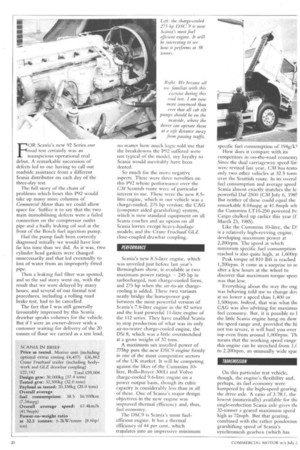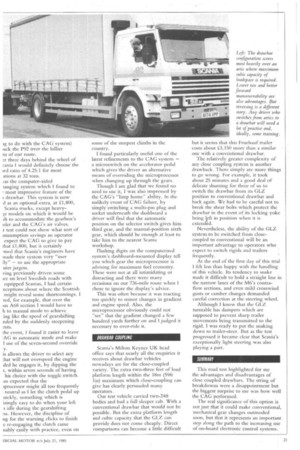F OR Scania's new 92 Series our road test certainly was
Page 22

Page 23

If you've noticed an error in this article please click here to report it so we can fix it.
an inauspicious operational trial debut. A remarkable succession of defects led to our having to call out roadside assistance from a different Scania distributor on each day of the three-day test.
The full story of the chain of problems which beset this P92 would take up many more columns of Commercial Motor than we could allow space for. Suffice it to say that the two main immobilising defects were a failed connection on the compressor outlet pipe and a badly leaking oil seal at the front of the Bosch fuel injection pump.
Had the pump fault been correctly diagnosed initially we would have lost far less time than we did. As it was, two cylinder head gaskets were changed unnecessarily and that led eventually to loss of water from an improperly fitted Pipe.
Then a leaking fuel filter was spotted, and so the sad story went on, with the result that we were delayed by many hours, and several of our formal test procedures, including a rolling road brake test, had to be cancelled.
The fact that I was still generally favourably impressed by this Scania drawbar speaks volumes for the vehicle. But if 1 were an owner-driver with a customer waiting for delivery of the 20 tonnes of flour we carried as a test load, no matter how much logic told me that the breakdowns the P92 suffered were not typical of the model, my loyalty to Scania would inevitably have been dented.
So much for the more negative aspects. There were three novelties on this P92 whose performance over the CM Scottish route were of particular interest to me. These were the new 8.5litre engine, which in our vehicle was a charge-cooled, 275 hp version; the CAG (computer aided gcarshifting) system, which is now standard equipment on all Scania coaches and an option on all Scania lorries except heavy-haulage models; and the Crane Fruehauf GLZ close-coupled drawbar coupling.
PERFORMANCE Scania's new 8.5-litre engine, which was unveiled just before last year's Birmingham show, is available at two maximum power ratings — 245 hp in turbocharged, non charge-cooled form, and 275 lap when the air-to-air chargecooling is added. These two variants neatly bridge the horsepower gap between the most powerful version of Scania's 7.8-litre engine in the 82 series and the least powerful 11-litre engine of the 112 series. They have enabled Scania to stop production of what was its only air-to-water charge-cooled engine, the DSi 8, which was a little overstretched at a gross weight of 32 tons.
A maximum net installed power of 275hp puts the new DSC9 engine firmly in one of the most competitive sectors of the UK market. It will be competing against the likes of the Cummins 10litre, Rolls-Royce 300Li and Volvo charge-cooled 9.6-litre engine on a power output basis, though its cubic capacity is considerably less than in all of these. One of Scania's major design objectives in the new engine was improved thermal efficiency and, thus, fuel economy.
The DSC9 is Scania's most fuelefficient engine. It has a thermal efficiency of 44 per cent, which translates into an impressive minimum specific fuel consumption of 194g/10
How does it compare with its competitors in on-the-road econom). Since the dual carriageway speed lirr were revised last year, CM has testo only two other vehicles at 32.5 tonn over the Scottish route. In its overal. fuel consumption and average speed Scania almost exactly matches the le: powerful Daf 2500 (CM July 6, 1985 But neither of these could equal the remarkable 8.04mpg at 41.8mph wh the Cummins LT10-250 powered Fe Cargo chalked up earlier this year (C March 23, 1985).
Like the Cummins 10-litre, the D: is a relatively high-revving engine, developing maximum power at 2,200rpm. The speed at which minimum specific fuel consumption reached is also quite high, at 1,600rp Peak torque of 810 lbft is reached 1,200rpm. It came as a surprise to in after a few hours at the wheel to discover that maximum torque spee( was that low.
Everything about the way the eng was behaving told me to change do% at no lower a speed than 1,400 or 1,500rpm. Indeed, that was what th( CAG was also advising for maximui fuel economy. But, it is possible to 1 the little Scania engine hang on dow the speed range and, provided the hi not too severe, it will haul you over top even from around 1,000rpm. Th means that the working speed range this engine can be stretched from 1,C to 2,200rpm, an unusually wide spar TRANSMISSION On this particular test vehicle, though, the engine's flexibility and, perhaps, its fuel economy were hampered by the high-speed gearing the drive axle. A ratio of 3.78:1, the lowest (numerically) available for tilt single-reduction Scania axle gives the 32-tonner a geared maximum speed high as 72mph. But that gearing, combined with the rather ponderous gearshifting speed of Scania's synchromesh gearbox (which has g to do with the CAG system) ack the P92 over the hillier ns of our route.
three days behind the wheel of L-ania I would definitely choose the ird ratio of 4.25:1 for most ations at 32 tons, 7as the computer-aided imaging system which I found to t most impressive feature of the drawbar. This system is now d as an optional extra, at .M800, Scania trucks, 'except heavyle models on which it would be lit to accommodate the gearbox's oler and the CAG's air valves.
r test could not show what sort of onsurnption savings an operator expect the CAG to give to pay that £1,800, but it certainly Ined that Scania's engineers have iiade their system very "user [Iy" — to use the appropriate uter jargon.
ving previously driven some Ice on level Swedish roads with equipped Scanias, I had certain nceptions about where the Scottish might reveal some shortcomings. I ted, for example, that over the ,us A68 section I would have to
h to manual mode to achieve ing like the speed of gearshifting nded by the suddenly steepening the event, I found it easier to leave ,AG in automatic mode and make I use of the seven-second override y.
is allows the driver to select any :hat will not overspeed the engine ded he engages it, by dipping the 1, within seven seconds of having his choice with the toggle switch. so expected that the )processor might all too frequently neutral as 'I let the clutch pedal up uickly, something which is isingly easy to do when your left s idle during the gearshifting ss. However, the discipline of ng for the warning clicks to finish c re-engaging the clutch came nably easily with practice, even on some of the steepest climbs 'in the country.
I found particularly useful one of the latest refinements to the CAG system — a microswitch on the accelerator pedal which gives 'the driver an alternative means of overriding the microprocessor when changing up through the gears.
Though I am glad that we found no need to use it, I was also impressed by the CAG's "limp home" ability. In the unlikely event of CAG failure, by simply switching a multi-pin plug and socket underneath the dashboard a driver will find that the automatic position on the selector switch gives him third gear, and the manual-position sixth gear, which should be enough at least to take him to the nearest Scania workshop.
Flashing digits on the computerised system's dashboard-mounted display tell you which gear the microprocessor is advising for maximum fuel economy. These were not at all intimidating or distracting and there were many occasions on our 736-mile route when chose to ignore the display's advice.
This was often because it was reacting too quickly to minor changes in gradient and engine speed. Also, the microprocessor obviously could not "see" that the gradient changed a few hundred yards further on and I judged it necessary to over-ride it.
NAM COUPLING
Scania's Milton Keynes UK head office says that nearly all the enquiries it receives about drawbar vehicles nowadays are for the close-coupled variety. The extra two-three feet of load platform length within the 18m (59ft lin) maximum which close-coupling can give has clearly persuaded many operators.
Our test vehicle carried twos24ft bodies and had a full sleeper cab. With a conventional drawbar that would not be possible. But the extra platform length and cubic capacity that the GLZ can provide does not come cheaply. Direct comparisons can become a little difficult
but it seems that this Fruehauf trailer cOsts 'about £3,150 more than a similar one With a conventional drawbar.
The relatively greater complexity of any close coupling system is another drawback. There simply are more things to go wrong. For example, it took about 25 minutes and a good deal of delicate shunting for three of us to switch the drawbar from its GLZ position to conventional drawbar and back again. We had to be careful not to break the shear bolts which protect the drawbar in the event, of its locking yoke being left in position when it is cxtendtd.
Nevertheless, the ability of the GLZ system to be switched from closecoupled to conventional will be an important advantage to operators who expect to switch rigids and trailers frequently. • At the end of the first day of this trial I felt less than happy with the handling of this vehicle. its tendency to snake made it difficult to hold a straight line in the narrow lanes of the PACs contraflow sections, and even mild crosswind gusts or camber changes demanded careful correction at the steering wheel.
Although I know that the GLZ turntable has dampers which are supposed to prevent sharp trailer movements being transmitted to the rigid, I was ready to put the snaking down to trailer-steer. But as the test progressed it became clear that Scania's exceptionally light steering was also playing a part.
SUMMARY
This road test highlighted for me the advantages and disadvantages of close coupled drawbars. The string of breakdowns were a disappointment but the biggest surprise to me was how well the CAG performed.
The real significance of this option is not just that it could make conventional, mechanical gear changes outmoded soon, but that it represents an important step along the path to the increasing use of on-board electronic control systems.












































































